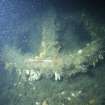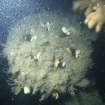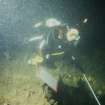Excavation
Date May 2002
Event ID 556656
Category Recording
Type Excavation
Permalink http://canmore.org.uk/event/556656
Two trial trenches excavated on the wreck near Kinlochbervie.
NC 1863 5399 The wreck occupies an exposed situation within a cove 4 miles SW of Kinlochbervie. The upper part of the site comprises a rocky outcrop at about 4m depth which steps down into a gully at a depth of about 14m. Two anchors and a cannon lie within a sand- and gravel-filled depression in an area of high energy environment within the surf zone. The main concentration of remains comprises two distinct groups of artefacts within an area measuring about 22 x 8m at the foot of an underwater cliff and at a depth of between 25-30m. The main deposit of the pottery assemblage is scattered over bedrock, in rock crevices and in gaps between the boulders. Mobile sand has accumulated in places, while less mobile deposits of gravel and other materials are found in the deeper gullies. The flat sandy seabed (a moderate to low energy environment) is found at a depth of 34m.
Fieldwork carried out in May 2002 aimed to locate further portions of the site (particularly within the kelp zone), to delineate its extent, and to identify diagnostic features of specific artefacts (notably the guns and anchors). It was also intended to investigate the site formation processes, to establish the value of various site monitoring techniques and to explore the potential of buried archaeological material.
Diving was possible at all states of the tide but some time was lost to bad weather; both surface demand and air systems were was used. Recording was by planning frame and DSM, on the basis of established control points. The objectives were achieved through diver searches (supplementary to caesium magnetometer searches carried out by the archaeological diving unit in 2001) and these established the boundaries of the remains. The identification of a sounding lead, two anchors and a gun in the shallows confirms that at least one portion of the ship reached this area, possibly after striking one of the many offshore skerries (which have not been investigated).
Four iron anchors and two cast-iron guns were recorded in situ; a report of a further gun in shallow water remains unconfirmed. Other finds are predominantly brick, slag, tile and pottery. A metal disc and a piece of lead sheet were also found.
The size, position and pairing of the anchors suggest an identification as two pairs of bower and sheet anchors, while they may be attributed to the 16th or 17th centuries AD. The cannon include examples of saker and minion types, the remains of carriages surviving in three cases. No reliable date can be inferred, but these pieces would be consistent with the armament expected of a merchant vessel of medium to large size. A ship armed exclusively with cast-iron guns would usually be considered to post-date the Armada, falling within the first quarter of the 17th century or later. The brick and tile finds were closely spaced (although a limited sample), and so probably represent the galley rather than the remains of ballast. This suggestion is consistent with the presence of olive jars and the tripod pipkin (recovered in 2001) which bear evidence of charring.
Ceramic finds include maiolica (Majolica) ware and Iberian coarseware. The pottery finds display a random scatter, with little evidence of movement since sinking. This may suggest that the impact took place in shallow water on the rocks, the contents of the vessel being then dispersed over the cliff. The Majolica ware was presumably carried as cargo or in passenger baggage, rather than for use on board.
Limited excavation within the deeper part of the site served to demonstrate that the bottom sediments would not support the survival of organic remains, but that numerous small gullies may remain buried.
A date around the first quarter of the 17th century is tentatively suggested for this wreck. The ship clearly had strong Mediterranean origins and probably originated in the Iberian or Mediterranean basin. The identified remains are interpreted as those of the galley and holds of what was probably a merchant vessel rather than a specialist warship. Further finds may be expected over a considerable area.
Sponsor: HS
P Robertson 2002.

































